new posts in all blogs
Viewing: Blog Posts Tagged with: julie paschkis, Most Recent at Top [Help]
Results 1 - 16 of 16
How to use this Page
You are viewing the most recent posts tagged with the words: julie paschkis in the JacketFlap blog reader. What is a tag? Think of a tag as a keyword or category label. Tags can both help you find posts on JacketFlap.com as well as provide an easy way for you to "remember" and classify posts for later recall. Try adding a tag yourself by clicking "Add a tag" below a post's header. Scroll down through the list of Recent Posts in the left column and click on a post title that sounds interesting. You can view all posts from a specific blog by clicking the Blog name in the right column, or you can click a 'More Posts from this Blog' link in any individual post.
Now let's load some serious love all over the Cybils Poetry Award Winner for 2015! Over at her Poetry for Children blog, Sylvia Vardell summarizes the process of nomination and first-round panel selections for this award. These fine folks read widely and chose seven outstanding books as finalists.
I served as one of the 2nd round judges who studied and discussed the merits of these seven finalists in passionate detail, with guidance from Jone MacCulloch. Now, after keeping mum for almost two weeks, Diane Mayr, Rosemary Marotta, Linda Baie, the aforementioned Laura Shovan and I can shout our choice from the tops of our blogs! (Drum roll please....)
The 2015 Children's and Young Adult Bloggers Literary Award
for Poetry goes to...
FLUTTER AND HUM/ALETEO Y ZUMBIDO
by Julie Paschkis
 0 Comments on announcing...Cybils Poetry Award Winner 2015! as of 2/14/2016 3:46:00 PM
0 Comments on announcing...Cybils Poetry Award Winner 2015! as of 2/14/2016 3:46:00 PM
"The Wild Wolverine!" with artwork in the style of the most excellent
Julie Paschkis!
 P. Zonka Lays an Egg
P. Zonka Lays an Egg
by Julie Paschkis
(Peachtree Publishers, 2015)
A gorgeous new picture book for Easter, about a hen who lays no ordinary eggs but colourful, patterned ‘pysankas’ – … Continue reading ... →

By: Mike Cressy,
on 6/8/2014
Blog:
Sugar Frosted Goodness
(
Login to Add to MyJacketFlap)
JacketFlap tags:
julie paschkis,
exhibit,
murals,
richard jesse watson,
craig orback,
stephanie lile,
MikeCressy,
Tacoma History Museum,
ernest oglby punkweiler,
time intrusionator,
Add a tag
That's me in the chair in, posed with the other artists in the exhibit (from left to right) Craig Orback,
Richard Jesse Watson, Julie Paschkis, along with the director Stephanie Lile in front of one of my murals.
Karla's quilt is unlike any other: it comforts her as she falls asleep with stories of the squares that make it up. Through the quilt, she learns about her grandparents' love, her aunt's imagination, and her mother's adventurous childhood. When Karla's new baby sister moves into her bedroom, Mooshka falls silent. After using Mooshka to appease her crying sister, Karla learns that family stories are for sharing.
To read my full review,
click here.

By:
Aline Pereira,
on 9/25/2011
Blog:
PaperTigers
(
Login to Add to MyJacketFlap)
JacketFlap tags:
Chile,
Picture Books,
picture book biography,
Julie Paschkis,
Bilingual books,
Monica Brown,
Poetry Books,
Cultures and Countries,
Week-end Book Reviews,
Pablo Neruda: Poet of the People,
Add a tag
 Monica Brown, illustrated by Julie Paschkis,
Monica Brown, illustrated by Julie Paschkis,
Pablo Neruda: Poet of the People
Henry Holt, 2011.
Ages 4-8
Pablo Neruda: Poet of the People, a picture book biography by Peruvian-American scholar Monica Brown, exudes the spirit of Neruda’s poetry without quoting a single line. The work of award-winning illustrator Julie Paschkis contributes greatly to the success of the book. Beginning with his childhood love of nature and the teacher who inspired him to become a writer, Brown traces Neruda’s rich life, including the awakening of his political consciousness, his escape from Chile over the Andes, and even the houses he treasured over his lifetime. Her language has its own poetry:
“He wrote about scissors and thimbles and chairs and rings.
He wrote about buttons and feathers and shoes and hats.
He wrote about velvet cloth the color of the sea.”
Integrating streams of Spanish and English words into every illustration, Paschkis’s folk-art paintings capture Neruda’s poetic sensibility in visual form. Amidst the masks and clocks and seashells, the fruit and spectacles and pottery, that she depicts to accompany the above text, Paschkis weaves evocative and beautiful words from Neruda’s poems: alcachofa, thistle, clavos, whistle, thrum, timber, azul, apple…
To illustrate Neruda’s participation in a coal miners’ strike, Paschkis pictures people waving word-streaked banners: recoger, defend, nunca, libre, friend, corazón. “When he saw that they were cold and hungry and sick, he decided to share their story,” Brown writes. “Even when his poems made leaders angry, he would not be silenced, because he was a poet of the people.”
An author’s note at the back of the book gives a summary of Neruda’s life, including the names of some of his most famous poems. A resources page follows with a bibliography of Neruda’s poetry books and a reading list of further biographical reading.
This latest in Brown’s biographical series will be welcomed by parents and teachers eager to introduce Neruda’s magical poetry to young readers. (Brown’s earlier books for children include bilingual biographies of Gabriel García Márquez and of Neruda’s seminal teacher, Gabriela Mistral.) The sounds of the words included to illustrate the story of the beloved writer’s life capture the beauty and mystery of poetry for adults and children alike.
Charlotte Richardson
September 2011
More and more writers and illustrators are discovering the mysterious interplay between art and yoga, and how yoga seems to serve as a catalyst for creativity.It was yoga that inspired illustrator Julie Paschkis and poet Janet Wong to collaborate on Twist: Yoga Poems, a collection of sixteen poems and illustrations which explore a variety of yoga poses. The book, which was named a Bank
 Today’s post has been the hardest post to research since I began this blog. Why? Well, as part of Reading Round Europe I’ve been searching and searching for almost 6 months (yes, half a year – that’s how dedicated I am!) for some fantastic Danish picture books available in English translation to bring to you, to share with my girls and for us all to enjoy. But have I been able to find any?
Today’s post has been the hardest post to research since I began this blog. Why? Well, as part of Reading Round Europe I’ve been searching and searching for almost 6 months (yes, half a year – that’s how dedicated I am!) for some fantastic Danish picture books available in English translation to bring to you, to share with my girls and for us all to enjoy. But have I been able to find any?
Barely. I’ve found one or two Danish picture books that were nice enough, but not so brilliant, and I’ve seen references to one or two on the internet which I then haven’t been able to get hold of to read, let alone review. What’s going on with Danish children’s literature? Why are so few Danish picture books translated into English?
Nina Christensen, Associate professor at the Centre for Children’s Literature (Center for Børnelitteratur) wrote to me:
“I think one explanation could be different views on childhood and of the role of the adult in relation to children’s books.
You might find it a provocative statement, but when I enter a children’s book shop in England – or Sweden for that matter – I find that a majority of books are made in a way so that neither child nor parent/adult is challenged too much. Generally speaking picture books seem to confirm existing norms and conventions.
A lot of Danish picture books are also like that. But I think there is also a tendency in picture books from Denmark (and Norway), to expand the borders of how you can address also small children and which kind of stories you can tell them. Today, I am working on a presentation of some recently published Danish picture books: One of them is about children in a concentration camp (illustrations by Dorte Karrebæk), one of them about a girl in a third world country who lives in a dumping ground, and in a new humoristic and ironic version of H.C. Andersen’s “What the Old Man Does is Always Right” the main character, Osama, meets three prostitutes, a drug dealer and a homeless character.
Very simply put: In some Danish (and Norwegian) picture books (older) children are exposed to i.e. cruelty towards children, naked children, sex, less than ideal behavior presented in an ironic manner etc. In relation to these examples, the child reader is supposed to be “competent” – not an individual who should always be protected from strong or strange impressions. I think this could be one of reasons why so few of them are translated. I might be wrong.”
I’d love to be able to research this thesis. Certainly it seems to be a plausible hypothesis if you also look at an article in IBBY’s Bookbird journal, “A Challenge to Innocence – ‘Inappropriate’ Picturebooks for Young Readers” by Carol Scott (2005, Vol 43, no. 1 – available to read for free in pdf form here)

Photo: Mads Boedker
4 Comments on This post has taken me 6 months to write…, last added: 5/9/2011

Welcome everyone to the First Possibly Annual (But Let's Just See How This Goes) Summer Fun Creative Spaces Book Cover Bingo Game! As of typing this post there were 56 people signed up to play--considering my goal was to have enough people signed up that all the prizes could be won, I think you could say I was happily surprised. (And still, great odds for you to win!) Thank you to each of you for participating. Because of you all, we're in for a fun month!
So, everybody have their crisply printed game card? Daubers ready? (If you are visiting here for the first time, visit here for a full run-down on how to play. You are more than welcome to join the game at any point this month.)
Some parting words before I draw our first Bingo cover:
May the force be with you.
The first Bingo book cover is
Through Georgia's Eyes by Rachel Rodriguez, illustrated by Julie Paschkis! Rachel's creative space was featured on March 8.
Visit her interview to see the critters who keep her company (and loot her chocolate drawer) while she works, or to learn about the power of the PWN. Julie was
featured on April 26. She has one of the cutest little work distractions I think I've seen.

By:
Julie Fortenberry,
on 11/14/2009
Blog:
Children's Illustration
(
Login to Add to MyJacketFlap)
JacketFlap tags:
Judy Schachner,
addictive colors,
Georgia OKeeffe,
Ora Eitan,
Skippyjon Jones,
Kathryn Lasky,
Julie Paschkis,
Henry Cole,
Erica S. Perl,
Jeanette Winter,
Add a tag
In my imaginary spectrum of picture books that appeal to children, I place Chicken Butt and Skippyjon on one end, and Georgia Rises, A Day in the Life of Georgia O'Keeffe, on the other. Georgia Rises is beautifully written by Kathryn Lasky and beautifully illustrated by Ora Eitan. How appealing it is to kids, I don't know. It could be quiet and poetic enough to tip it off the kid-appeal spectrum. But as I write this I realize that the real focus of the book is color, and color is an interesting subject to a lot of kids. My kids had favorite colors from about the age of 3, and their favorites kept changing.
There are (at least) two other picture books about O'Keeffe: My Name is Georgia by Jeanette Winter, and Through Georgia's Eyes by Rachel Victoria Rodriguez, illustrated by the marvelous Julie Paschkis.
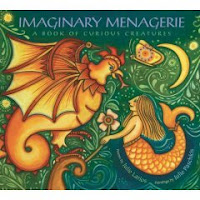
Imaginary Menagerie combines mythological creatures, crisp poems for the four-to eight-year old reader, and sumptuous illustrations into one first-class picture book. Imaginary Menagerie is an instant classic--one that will appeal to boys and girls, one that makes a great bedtime read and a classroom staple. It's a knockout.
Subtitled A Book of Curious Creatures, Imaginary Menagerie puts the emphasis on curious. Poet Julie Larios writes about, or from the point of view of, a variety of fascinating creatures--including the Centaur, Hobgoblins, Gargoyles, Naga, and the Sphinx among others. Larios's poems rhyme, but each individual poem has its own rhyme scheme and meter. Larios keeps it simple for her intended audience, but includes a sly touch of humor or moments of solemnity for older children and adults reading this beauty aloud. Take, for example, the final three lines of the six-line "Centaur": "Can he be half man, half horse?/The answer is no./And yes, of course." Or, consider the final four lines of "Sphinx": "But the cat-man sleeps./He never even stirs./No one can answer/the sand."
And Julie Paschkis's illustrations? They are dramatic, rich in color, and simply gorgeous. They resemble stylized woodcuts infused with deep, warm color. Paschkis modifies her paintings ever so slightly--but not too much so that she loses her own style--to match the culture from which the subject was born. Paschkis's Sphinx is more angular, more elongated than her other subjects, her Firebird explodes into a Russified sky, Thunderbird appears as a totem figure on the move.
Imaginary Menagerie: A Book of Curious Creatures is a book to treasure, a book to give, a book to keep forever.
----------------------
Other Blog Reviews:
Seven Impossible Things Before Breakfast (Don't miss this one: Jules and Eisha share a poem from Imaginary Menagerie and illustrations from the book.)
Charlotte's Library
Kelly Fineman (scroll down)
-----------------------
I thought of writing an original poem this week on the subject of grading final papers. Then I realized it would go something like this:
grading
grading
grading
grading
gra-
and decided to write a review instead. Here's wishing you a happy Poetry Friday. The Two Writing Teachers are on the roundup.

By:
Aline Pereira,
on 9/5/2007
Blog:
PaperTigers
(
Login to Add to MyJacketFlap)
JacketFlap tags:
Authors,
Picture Books,
Julie Paschkis,
Illustrators,
Glass Slipper Gold Sandal,
multicultural Cinderella,
Paul Fleishman,
Shen-s Books,
Children's Books,
Add a tag
Glass Slipper, Gold Sandal, the new picture book by Newbery Award winner Paul Fleishman, takes the story of Cinderella for a spin around the world. Fleishman starts out traditionally, “Once upon a time there lived a wealthy merchant whose wife had died. They had one daughter, gentle-eyed and good-hearted.” But once the stepmother messes things up and Cinderella cries, the story takes several directions. “…the animal poured honey for her from its horn…and a fairy gave her figs and apricots…and Godfather Snake gave her rice.”
By the time the prince/king/headman marries Cinderella, the page is overflowing with dancers and food from Zimbabwe to Korea, and readers of all ages will be under the spell of Fleishman’s lovely worldwide enchantment. Illustrator Julie Paschkis traces the story variations with colorful bands of textile-inspired images, labeled with country of origin. Click here and scroll down for an interview with Glass Slipper, Gold Sandal’s illustrator extraordinaire.
Fleishman may be the first to meld so many Cinderella tales into one narrative. In doing so, he communicates something very special about this beloved story. But Cinderella’s multiculturalism is well documented; here’s an ALA BookLinks list of worldwide Cinderellas by region and culture. Here’s an extensive list from the Cinderella specialists, our friends at Shen’s Books. You can also search for Cinderella, if not her glass slipper, here at PaperTigers.
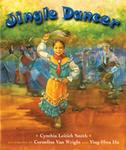 Jingle Dancer by Cynthia Leitich Smith, illustrated by Cornelius Van Wright and Ying-Hwa Hu (Morrow/HarperCollins, 2000) has been named among best Multicultural Books for Early Childhood Educators in the most current issue of Montessori Life, Volume 19, Number 1, 2007. See page 97. Thanks to Debbie Gonzales for letting me know about this honor.
Jingle Dancer by Cynthia Leitich Smith, illustrated by Cornelius Van Wright and Ying-Hwa Hu (Morrow/HarperCollins, 2000) has been named among best Multicultural Books for Early Childhood Educators in the most current issue of Montessori Life, Volume 19, Number 1, 2007. See page 97. Thanks to Debbie Gonzales for letting me know about this honor.
In other news, Finding Wonderland: The WritingYA Weblog discusses my revision process as mentioned in my recent interview on Tantalize (Candlewick, 2007) at Not Your Mother's Book Club.
Thanks to A Fuse #8 Production for highlighting the YABC giveaway contest (20 copies of Tantalize) and Greg's post "How Bleak Thou Art." Thanks also to Stephanie Burgis for ordering Tantalize (enjoy!).
More News & Links
Poetry Friday: Yoga Poems. A recommendation of Twist: Yoga Poems by Janet Wong, illustrated by Julie Paschkis (McElderry, 2007). Source: Writing with a Broken Tusk by Uma Krishnaswami. Read an interview with Uma.
If you haven’t read my interview with Janet and Julie yet, I suggest you check that out before you read today’s post.


Interview Addendum
Elaine: Does either of you have any other books that will be published in 2007?
Julie: I am very excited about a book I illustrated that is coming out later this year from Henry Holt. It is called GLASS SLIPPER, GOLD SANDAL: A WORLDWIDE CINDERELLA and it was written by Paul Fleischman. It weaves together Cinderella stories from all around the world. It will be released in September.
Janet: Do you know about BEFORE IT WRIGGLES AWAY, my Meet the Author book (Richard C. Owen Publishers) that came out in January of this year? It's still not available through amazon.com (groan), but RC Owen sells it directly:
http://www.rcowen.com/MTA-JanetWong.htm

A Sneak Peek at a “Potential Project” from Julie and Janet
Elaine: Do the two of you have any plans to collaborate on a fourth book that you'd be willing to share with us?
Janet: Julie and I currently aren't actively working on a new collection but on a possible collection. Let's see if Julie is interested in "going public" with that, though, since it's still very tentative...
Julie, do you want to share an image from your Liberty Notes along with one or two of my DECLARATION OF INTERDEPENDENCE poems?
Julie: I'm happy to talk about this possible project! I've attached two of the images illustrating the 1st amendment (freedom of speech) and 4th amendment (freedom from unreasonable search and seizure) from a series of cards I made and sell to benefit the ACLU. The National Endowment for the Humanities recently used one of the images (The Pursuit of Happiness) in a library program they have.
Janet: Here's the text of the poems "Liberty" and "Declaration of Interdependence," both written to go with Julie's Liberty Notes (and hoping that they will be part of a fourth book called DECLARATION OF INTERDEPENDENCE):
Freedom of Speech
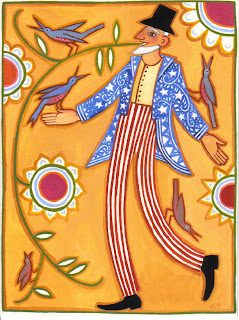
Declaration of Interdependence
by Janet Wong
We hold these truths to be not-so-self-evident
(but think about them a while, and hopefully you might agree):
all men are created equally a puzzle, made up of so many parts;
each of us makes up part of the greater puzzle that is our nation.
Lose one piece and the picture is incomplete. Recognizable, but
what happens when too many pieces, one by one, become lost?
Life, Liberty and the pursuit of Happiness: do your best to find
the pieces that fit, that need you, as much as you need them.
Freedom from Unreasonable Search and Seizure 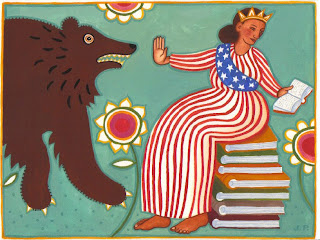
Liberty
by Janet Wong
I pledge acceptance
of the views,
so different,
that make us America
To listen, to look,
to think, and to learn
One people
sharing the earth
responsible
for liberty
and justice
for all.
Elaine: Janet and Julie, Thank you so much for the wonderful interview and for an inside look at your collaborative process that brought us TWIST: YOGA POEMS—your third fine book of poetry and art. I do hope the “possible” project that you two have been working on gets published in the not-too-distant future. It looks like a great book in the making!
A Few More Words
I’d like to tell everyone how much I enjoyed conducting my “interview via email” with Janet and Julie. They responded promptly to all my questions and were so forthcoming with information about their author and illustrator process for TWIST: YOGA POEMS that writing up the interview for Blue Rose Girls was easy—easy once I color coded their responses in my Word document draft.
I should tell you, too, that it was Janet who suggested I include Julie in the interview. I had originally planned to write a blog interview with Janet about her poetry books. When I saw a copy of TWIST, I wrote Janet to tell her how much I liked the book—and Julie’s gorgeous illustrations. So Janet asked Julie if she’d participate with her in an interview about the book. How lucky can a blogger get?
Two Other Great Poetry Books by Janet and Julie
NIGHT GARDEN: POEMS FROM THE WORLD OF DREAMS (2000) KNOCK ON WOOD: POEMS ABOUT SUPERSTITIONS (2003)
KNOCK ON WOOD: POEMS ABOUT SUPERSTITIONS (2003) 
(Both of these books were published by Margaret K. McElderry Books.)
TWIST: YOGA POEMS
Written by Janet Wong
Illustrated by Julie Paschkis
Margaret K. McElderry
(2007)
What a gorgeous book! Julie Paschkis outdid herself with her art for TWIST, a poetry collection written by Janet Wong. I thought YELLOW ELEPHANT was one of the best-illustrated children’s books of 2006. I know it’s early March—but I think TWIST may well be one of the best-illustrated books of 2007.
This is the third book of poetry written by Janet Wong that Paschkis has illustrated. NIGHT GARDEN: POEMS FROM THE WORLD OF DREAMS, the first collaboration between Wong and Paschkis, was a stunner. It was designated a New York Times Best Illustrated Book of 2000 and a National Council of Teachers of English Notable Children’s Book. Their second book, KNOCK ON WOOD: POEMS ABOUT SUPERSTITIONS, was a Riverbank Review Books of Distinction Finalist. Needless to say, I waited with anticipation for my review copy of TWIST to arrive from the publisher. As soon as I looked at the front cover and read the first poem, Breath, I knew I had in my hands another wonderful pairing of art and poetry from these two talented and accomplished women.
TWIST is a collection of poems about different yoga positions. There’s nothing fussy or pretentious about Wong’s poetry in this book. With well-honed writing and lyrical language that is accessible to young children, she captures the poetic essence of the yoga poses and creates tangible images of sixteen different body positions—including Warrior, Tree, and Crow. Paschkis’s vibrant watercolor illustrations are striking and meld into a visual harmony with Wong’s fine text.
This is an attractively designed book. The format of TWIST suits the subject matter of the poetry perfectly. Each two-page spread includes a poem that explains the meaning of a particular yoga position and a painting that illustrates that position. Both the illustration and the poem are set inside frames of the same size—with the illustration on the left-hand page and the poem on the right-hand page. This gives the effect of the poem and the painting being mirror images of each other. The framed paintings are set inside larger border-like illustrations, which also mirror each other. These larger illustrations include design details that extend the yoga theme of each of Wong’s poems.
Here are three examples from the book to show you how the art and text work together so beautifully to provide us with a unique artistic and literary interpretation of yoga.
From BREATH
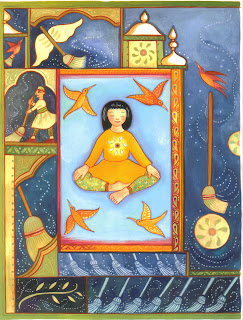
Breath is a broom
sweeping your insides.
Smooth and slow:
You pull scattered bits of dream fluff
And heart dust into neat piles…
Breath is a broom
sweeping you fresh.
From TREE
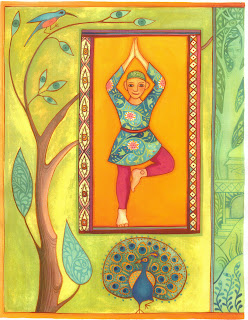
Trees watch.
This is why
they grow tall,
this is why they bend
and sway,
so they can see around
a house, over a hill,
beyond a fire…
At the tip of each branch
there is an eye.
LOW CROW
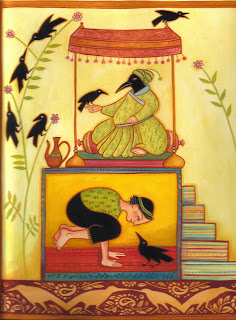
Crow depends on his elbows.
You cannot always fly.
You need to rest
the weight of yourself.
TWIST has the elements that I look for in an illustrated poetry book for children: well-written poetry with a new “twist” and art that not only adds visual interest to the book, but also adds another dimension to the author’s text.
An Interview with Janet Wong & Julie Paschkis

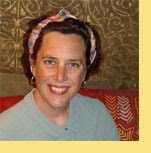 Janet and Julie were kind enough to let me interview them about their most recent collaboration on TWIST. Here’s a little background information first: Julie and Janet are friends. They met through Laura Kvanosky, author of ZELDA AND IVY: THE RUNAWAYS. Each of their three books has been submitted as an author/illustrator package, which is pretty unusual in the publishing world.
Janet and Julie were kind enough to let me interview them about their most recent collaboration on TWIST. Here’s a little background information first: Julie and Janet are friends. They met through Laura Kvanosky, author of ZELDA AND IVY: THE RUNAWAYS. Each of their three books has been submitted as an author/illustrator package, which is pretty unusual in the publishing world.
Elaine: Janet, in your Author's Note at the end of TWIST, you tell readers that you wrote the poems for Julie, who loves yoga and loves to stretch. Did you just sit down one day and decide you were going to write these poems for Julie...or was there something in particular that inspired you to so? I’d also like to know if you practice yoga.
Janet: Even though it has been years (and pounds) since I have practiced yoga, I did do the poses as I wrote the poems. I think my dog Nissa found it quite strange to see me typing away on the computer, then flopping suddenly down on the floor, stretching, then hopping back up to my desk for more typing. I'd be straining on the floor and she would come and lick my face in encouragement (or maybe sympathy).
I don't do enough exercise, and it was very good for me to have a reason to "have to" do yoga (apart from the health and spiritual benefits). One review suggested that this book was inspired by the "current yoga craze" but, actually, I started writing these poems in 2002, after Julie finished the paintings for KNOCK ON WOOD, and finished the poems in 2003. I was so pleased with what Julie had done in that book and wanted to give her another project, an "irresistible project." I chose yoga, knowing that she is passionate about yoga and practices it several times a week. I was a bit worried when I started seeing children's yoga books coming out. With each passing year, I worried that "the market" was disappearing. But this isn't a how-to book. I'm hoping that kids who have learned yoga will stumble on this book and feel a jolt of excitement at discovering a celebration of an important part of their lives.
Elaine: Julie, did you enjoy illustrating this book of poems that Janet wrote especially for you?
Julie: TWIST was great fun to illustrate. I do a lot of yoga so I felt like I knew the poses from the inside out (less googling than usual for reference). Janet's poems were surprising and just right. So many of the poses have animal names. She pushed those connections in ways that brought imagery to mind that was fun to paint. Now when I do yoga poses I often think of lines from her poems. I will be in cat pose and suddenly think of a pleasant bowl of cream.
Elaine: Janet, reviewers of TWIST have noted the variety of ethnicities Julie depicts in her paintings. Was this something the two of you discussed before she did the art for the book?
Janet: I like the fact that Julie varies the ethnicity of the children in our books. We have never discussed this with each other, but I feel it is very important for kids to see a variety of looks. Not just different races, but different hairstyles and body shapes. I'm happy to have inspired the roly-poly round-bellied "jelly doughnut" of a girl in the poem "Finding the Center" in TWIST. There's a secret truth in that painting that Julie didn't intend: the green apples in the foreground (painted by Julie to symbolize envy), actually (in my mind and personal history) symbolize Asians. When my grandfather learned that I was dating a white man (who later became my husband), he said, "There are green apples, red apples. We are green apples. But you need to try all kinds." My grandfather was about 85 years old when he told me this. He was quite poetic, a natural storyteller—and a very wise man.
The Jelly Doughnut and the Green Apples

Elaine: Julie, would like to speak to this diversity represented in the books you have illustrated for Janet?
Julie: I always want to include lots of different ethnicities so that children can see themselves. But also that reflects reality; on my block alone there are Indian, Chinese, Korean, Hispanic, black, white, and mixed race children.
Elaine: Julie, where did you get your inspiration for the art in TWIST?
Julie: I looked at a lot of Indian miniatures as I did the illustrations for TWIST. Since yoga comes from India it made sense for those pictures to influence the art in the book. I studied the miniatures for the colors and for the way space is divided up. I love how saturated the colors are in the Indian paintings. One interesting fact that I learned is that the intense yellow pigment in the miniatures was made from feeding mangos to the cows and then making paint from their dried urine. (I didn't use that technique.)
When I painted the clothing and the borders I looked at the Indian miniatures, at paintings of people in Indian clothing and at a Dover book of paisley patterns. I put all those ingredients in my head and painted the patterns based on those inspirations; they aren't exact copies of anything. I tried to make the patterns fit the poems. For example, in the illustration for the poem Triangle all of the patterns on the clothes are based on the triangle shape. Or in Cobra the border and clothing have lines that snake around.
Elaine: Janet, tell me about your author-illustrator relationship with Julie and why you love working with her.
Janet: Perhaps the most amazing thing about Julie is that she has made each book of ours significantly different from the last. People who look quickly might not notice the little differences, but all together they add up to something quite important.
For instance, NIGHT GARDEN: POEMS FROM THE WORLD OF DREAMS had no glossary of "dream interpretation" at the back. I thought that was fine; Julie, too, wanted to emphasize the poems and not distract the reader with psychobabble. Why, then, did we include "back matter" in KNOCK ON WOOD: POEMS ABOUT SUPERSTITIONS? Julie's curiosity about (and even, I would say, fascination with) superstitions, as well as the folkloric element of her paintings, led me to justify including a glossary (of sorts) at the end of the book. I say "of sorts" because, again, she encouraged me not to distract the reader with dry academic text, but rather to try to provide commentary that would be playful and inspire wonder. With TWIST: YOGA POEMS, I sought to replicate KNOCK ON WOOD's back matter with commentary or even instructions on the poses, but Julie was quite firm about not wanting that. I think that she has become increasingly certain with each book about how she wants it to look.
Julie is the only illustrator with whom I have this level of "back and forth"--or maybe I should say "back and back"! I like to consult her when the book is still being written, but she makes it pretty clear that I am to leave her alone to paint as she sees fit, once the manuscript is finalized.
Elaine: Julie, tell us what makes working with Janet and her texts so inspiring.
Julie: Our friendship grew out of working together. I think we spur each other on to create good work; I hope that A plus B equals more than C. I like illustrating Janet's poems because her imagery is like a diving board for my imagination. Also, her poems are subtle. When I read them over and over I notice the artistry in the construction of the poems and I find layers of meaning.
Come back on Sunday for a “sneak peek” at a potential Wong/Paschkis project!



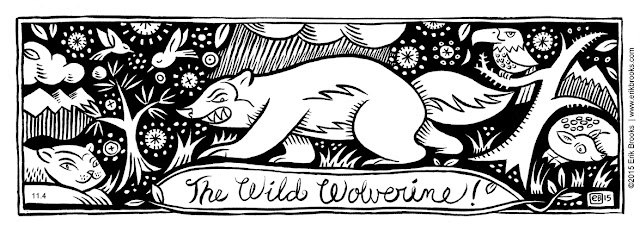
 P. Zonka Lays an Egg
P. Zonka Lays an Egg


 Monica Brown, illustrated by Julie Paschkis,
Monica Brown, illustrated by Julie Paschkis, Today’s post has been the hardest post to research since I began this blog. Why? Well, as part of
Today’s post has been the hardest post to research since I began this blog. Why? Well, as part of 













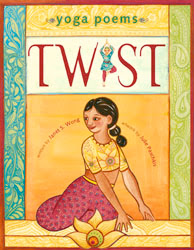






I just bought The Umbrella by Ingrid & Dieter Schubert from Amsterdam. It is an absolutely gorgeous book. Nothing to translate, though, as the picture book is wordless–but I thought you might like to know about it if you don’t already.
Cheryl Rainfield recently posted..Buying Picture Books as a Treat
Hi Kerri, Great to hear the book is in your local library. I hope you enjoy it when you get to read it!
Hi Catherine,
I’ll have to follow that one up. The author’s name looks like it could be Danish…
Zoe recently posted..Kidlit destinations in Denmark
Interesting letter and rationale.
I’ve had a terrible time finding Danish picture books in English. The ones we have are in simple Danish, we just translated as we read. And at least one of those is originally German.
I grew up with some relatively hard-headed Norwegian immigrant children’s authors in Minnesota where assimilation has been as delayed as everyone could make it (the D’Aulaire troll books, Wanda Gag). But no Danish ones.